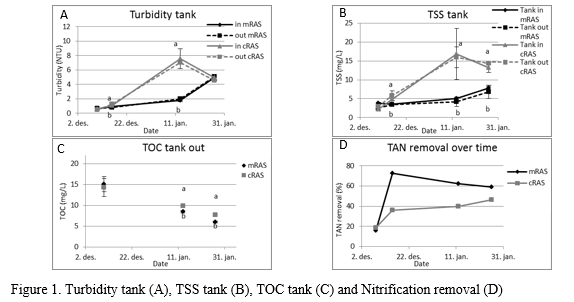EVALUATION OF MEMBRANE TREATMENT IN RECIRCULATING AQUACULTURE SYSTEMS (RAS) FOR ATLANTIC SALMON POST-SMOLTS (Salmo Salar)
Introduction
Accumulation of solids is a challenge in recirculating aquaculture systems (RAS), and could affect the water quality in several ways. Solids will dissolve and lead to elevated levels of fine particles, organic constituents and nitrogen compounds in the water. Small particles also act as bacterial substrate in RAS (Liltved & Cripps 1999) and may cause bacterial blooms under unstable conditions. Furthermore, solids could also reduce the effect of disinfection by shielding the microorganisms (Hess-Erga 2010), and affect the nitrification kinetics in the biofilters since the autotrophic nitrifying biomass easily can be outcompeted by the heterotrophic biomass (Guerdat et al 2011). Moreover, particles may cover the gill epithelium and affect the gill function , and it has been shown that skin and mucus abrasion enhances the invasion of pathogens (Madetoja et al 2000). The particle removal systems typically in use in RAS only manage to remove particles larger than 40-60 µm (Cripps & Bergheim 2000) leaving the fine suspended solids and colloids. Hence there is a clear need for an advanced particle removal system that is able to remove this fraction of particles. By integrating a membrane unit in the recirculating flow the accumulation of fine particles and colloids can be avoided. To be able to consider this technology for RAS, several aspects need to be evaluated such as the potential positive effect on the water quality and fish performance needs to be evaluated, as well as the operational experiences.
Method
System configuration and components
The recirculating systems were installed at Nofima Centre for Recirculation in Aquaculture (NCRA) (Terjesen et al 2013). This study compared a membrane modified RAS (mRAS) with a conventional RAS (cRAS) for production of Atlantic salmon post-smolts. The membrane unit installed was an ultrafiltration membrane (AQUAFLEX 64®, Pentair/X-flow, US) with a nominal pore size of 20 nm and a total area of 60m2. The membrane was connected to the outlet of the biofilter, and the clean permeate water was discharged into the pipe going back to the fish tanks. This setup filtered 5% of the total system flow for 10 h d-1, or 50% of the total system volume, and produced 2.5 m3 h-1 of clean water. The weight of the fish and the tank density at the start was 250 g and 50 kg/m3, respectively. Both systems were designed and operated equally through-out the experiment period of 50 days.
Analytical protocol
Analysis of physiochemical water quality parameters, total suspended solids (TSS), particle size distribution (PSD), turbidity and total number of bacteria was conducted on a regular basis. To investigate the TAN-removal efficiency of the biofilter, and the potential correlation to the organic material in the water, the different nitrogen compounds and the total organic carbon (TOC) was measured throughout the experiment. The fish performance was evaluated as growth rate and survival, and by external welfare score and gill histology.
Results
Already after one week of treatment, the membrane improved the water clarity visually and had a clear effect on several water quality parameters. The level of turbidity, the concentration of TSS and the total organic material (TOC) were lower in mRAS compared to cRAS (significance level) (p=0.05) (Fig. 1, A - C, respectively), and had a positive effect on the nitrification efficiency in the biofilter during the whole experiment (Fig. 1, D).
However the membrane set up for this study did not affect the fish performance significantly, when evaluated as growth rate and survival. Further results on membrane operational performance, water quality constituents, and fish health will be presented on the conference.
Acknowledgement
This study was founded by a Research Council of Norway strategic institute program (SIS), project number 194050/F40 (RASTech) "Development of future controlled-environment aquaculture". The membrane unit was supplied by Pentair (US).
References
Cripps SJ, Bergheim A. 2000. Solids management and removal for intensive land-based aquaculture production systems. Aquacultural Engineering 22: 33-56
Guerdat TC, Losordo TM, Classen JJ, Osborne JA, DeLong D. 2011. Evaluating the effects of organic carbon on biological filtration performance in a large scale recirculating aquaculture system. Aquacultural Engineering 44: 10-18
Hess-Erga OK. 2010. Disinfection of seawater and implications for ballast water treatment. NTNU, Trondheim
Liltved H, Cripps SJ. 1999. Removal of particle-associated bacteria by prefiltration and ultraviolet irradiation. Aquaculture Research 30: 445-50
Madetoja J, Nyman P, Wiklund T. 2000. Flavobacterium psychrophilum, invasion into and shedding by rainbow trout Oncorhynchus mykiss. Diseases of Aquatic Organisms 43: 27-38
Terjesen BF, Summerfelt ST, Nerland S, Ulgenes Y, Fjæra SO, et al. 2013. Design, dimensioning, and performance of a research facility for studies on the requirements of fish in RAS environments. Aquacultural Engineering 54: 49-63
